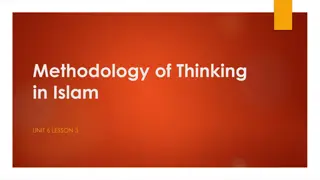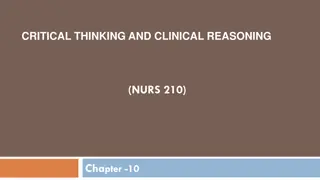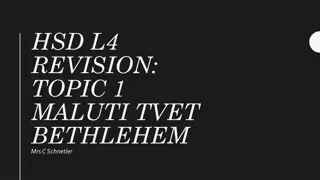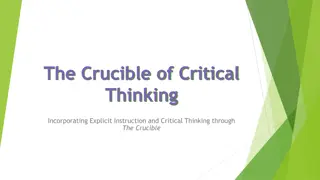Enhancing Critical Thinking Skills in College Education
Developing critical thinking skills is essential for success in college. This chapter explores various levels of cognitive processes from remembering to evaluating, guiding students on how to analyze information effectively and make informed decisions. By mastering these stages - remembering, understanding, applying, analyzing, and evaluating - students can enhance their learning experience and excel academically.
Download Presentation

Please find below an Image/Link to download the presentation.
The content on the website is provided AS IS for your information and personal use only. It may not be sold, licensed, or shared on other websites without obtaining consent from the author.If you encounter any issues during the download, it is possible that the publisher has removed the file from their server.
You are allowed to download the files provided on this website for personal or commercial use, subject to the condition that they are used lawfully. All files are the property of their respective owners.
The content on the website is provided AS IS for your information and personal use only. It may not be sold, licensed, or shared on other websites without obtaining consent from the author.
E N D
Presentation Transcript
Critical Thinking and Decision Making Chapter 6
Remembering When you are skilled in remembering, you can recognize or recall knowledge you ve already gained, and you can use it to produce or retrieve or recite definitions, facts, and lists. Remembering may be how you studied in grade school or high school, but college will require you to do more with the information. Examples include: identify relate list define recall memorize repeat record name
Understanding Understanding is the ability to grasp or construct meaning from oral, written, and graphic messages. Each college course will introduce you to new concepts, terms, processes, and functions. Once you gain a firm understanding of new information, you ll find it easier, perhaps later, to comprehend how or why something works. Examples include: restate locate report recognize explain express identify discuss describe discuss review infer illustrate interpret draw represent differentiate conclude
Applying When you apply, you use learned material (or you implement the material) in new and concrete situations. In college you will be tested or assessed on what you ve learned in the previous levels. You will be asked to solve problems in new situations by applying understanding in new ways. You may need to relate abstract ideas to practical situations. Examples include: apply relate develop translate use operate organize employ restructure interpret demonstrate illustrate practice calculate show exhibit dramatize
Analyzing When you analyze, you have the ability to break down or distinguish the parts of material into its components, so that its organizational structure may be better understood. At this level, you will have a clearer sense that you comprehend the content well. You will be able to answer questions such as what if, or why, or how something would work. Examples include: analyze compare probe inquire examine contrast categorize differentiate contrast investigate detect survey classify deduce experiment scrutinize discover inspect dissect discriminate separate
Evaluating With skills in evaluating, you are able to judge, check, and even critique the value of material for a given purpose. At this level in college you will be able to think critically, Your understanding of a concept or discipline will be profound. You may need to present and defend opinions. Examples include: judge assess compare evaluate conclude measure deduce argue decide choose rate select estimate validate consider appraise value criticize infer
Creating With skills in creating, you are able to put parts together to form a coherent or unique new whole. You can reorganize elements into a new pattern or structure through generating, planning, or producing. Creating requires originality and inventiveness. It brings together all levels of learning to theorize, design, and test new products, concepts or functions. Examples include: compose produce design assemble create prepare predict modify plan invent formulate collect generalize document combine relate propose develop arrange construct organize originate derive write propose
Blooms Taxonomy This video discusses Bloom s taxonomy learning levels with regard to student success in college. https://youtu.be/Qfp3x_qx5IM
The Power of Thought From Bloom s taxonomy of learning skills, you can see that thought and thinking can be understood as patterns systems and schemes within the mind. There is order and structure in the way we think and in the way we process and internalize information. As we look at patterns of thought, we can also think about the power of thought. For example, the act of thinking just thinking can affect not only the way your brain works but also its physical shape and structure. The following video explores some of these discoveries, which relate to all the thinking and thoughts involved in college success. https://youtu.be/-v-IMSKOtoE
Critical Thinking Skills What Is Critical Thinking? Critical thinking is clear, reasonable, reflective thinking focused on deciding what to believe or do. It means asking probing questions like, How do we know? or Is this true in every case or just in this instance? It involves being skeptical and challenging assumptions, rather than simply memorizing facts or blindly accepting what you hear or read.
Who are critical thinkers, and what characteristics do they have in common? Critical thinkers are usually curious and reflective people. They like to explore and probe new areas and seek knowledge, clarification, and new solutions. They ask pertinent questions, evaluate statements and arguments, and they distinguish between facts and opinion. They are also willing to examine their own beliefs, possessing a manner of humility that allows them to admit lack of knowledge or understanding when needed. They are open to changing their mind. Perhaps most of all, they actively enjoy learning, and seeking new knowledge is a lifelong pursuit.
Critical Thinking Critical Thinking IS Skepticism Examining assumptions Challenging reasoning Uncovering biases Critical Thinking is NOT Memorizing Group thinking Blind acceptance of authority
Questions a critical thinker asks 1. What s happening? Gather the basic information and begin to think of questions. 2. Why is it important? Ask yourself why it s significant and whether or not you agree. 3. What don t I see? Is there anything important missing? 4. How do I know? Ask yourself where the information came from and how it was constructed. 5. Who is saying it? What s the position of the speaker and what is influencing them? 6. What else? What if? What other ideas exist and are there other possibilities?
Critical Thinking Exercise Listen to four different scenarios that will be read by the instructor and use your critical thinking skills to come to a conclusion as to what happened.
Problem-Solving Action Checklist Problem-solving can be an efficient and rewarding process, especially if you are organized and mindful of critical steps and strategies. Remember, too, to assume the attributes of a good critical thinker. If you are curious, reflective, knowledge-seeking, open to change, probing, organized, and ethical, your challenge or problem will be less of a hurdle, and you ll be in a good position to find intelligent solutions. STRATEGIES/ACTION CHECKLIST Define the problem: Identify the problem, Provide as many supporting details as possible, Provide examples, Organize the information logically Identify available solutions: Use logic to identify your most important goals, Identify implications and consequences, Identify facts, Compare and contrast possible solutions Select your solution: Use gathered facts and relevant evidence, Support and defend solutions considered valid, Defend your solution
Critical Thinking and Decision Making Read through the six strategies at the end of the critical thinking section and list five suggestions that could help you think through your options and make your decision. Submit your activity through the turnitin link provided on blackboard. Assignment is due by 11:59 pm tonight, March 21st.
Creative Thinking Skills Creative thinking (a companion to critical thinking) is an invaluable skill for college students. It s important because it helps you look at problems and situations from a fresh perspective. Creating thinking is a way to develop novel or unorthodox solutions that do not depend wholly on past or current solutions. It s a way of employing strategies to clear your mind so that your thoughts and ideas can transcend what appear to be the limitations of a problem. Creative thinking is a way of moving beyond barriers.[1] As a creative thinker, you are curious, optimistic, and imaginative. You see problems as interesting opportunities, and you challenge assumptions and suspend judgment. You don t give up easily. You work hard.[2] Is this you?
ACTIVITY: ASSESS YOUR CREATIVE PROBLEM-SOLVING SKILLS Objective Evaluate your attitude toward problem-solving in the context of cultivating creative thinking. Directions: Access Psychology Today s Creative Problem-Solving Test at the Psychology Today Web site. Read the introductory text, which explains how creativity is linked to fundamental qualities of thinking, such as flexibility and tolerance of ambiguity. Then advance to the questions by clicking on the Take The Test button. The test has 20 questions and will take roughly 10 minutes. After finishing the test, you will receive a Snapshot Report with an introduction, a graph, and a personalized interpretation for one of your test scores. Complete any further steps by following your instructor s directions. Print out your report and submit to your Professor for participation credit for today s class.
Creative Thinking in Education College is great ground for enhancing creative thinking skills. The following are some college activities that can stimulate creative thinking. Are any familiar to you? Design sample exam questions to test your knowledge as you study for a final. Devise a social media strategy for a club on campus. Propose an education plan for a major you are designing for yourself. Prepare a speech that you will give in a debate in your course. Develop a pattern for a costume in a theatrical production. Arrange audience seats in your classroom to maximize attention during your presentation. Arrange an eye-catching holiday display in your dormitory or apartment building. Participate in a brainstorming session with your fellow musicians on how you will collaborate to write a musical composition. Draft a script for a video production that will be shown to several college administrators. Compose a set of requests and recommendations for a campus office to improve its customer service. Develop a marketing pitch for a mock business you are developing. Develop a comprehensive energy-reduction plan for your cohousing arrangement.
How to Stimulate Creative Thinking Sleep on it. Over the years, researchers have found that the REM sleep cycle boosts our creativity and problem-solving abilities, providing us with innovative ideas or answers to vexing dilemmas when we awaken. Keep a pen and paper by the bed so you can write down your nocturnal insights if they wake you up. Go for a run or hit the gym. Studies indicate that exercise stimulates creative thinking, and the brainpower boost lasts for a few hours. Allow your mind to wander a few times every day. Far from being a waste of time, daydreaming has been found to be an essential part of generating new ideas. If you re stuck on a problem or creatively blocked, think about something else for a while. Keep learning. Studying something far removed from your area of expertise is especially effective in helping you think in new ways. Put yourself in nerve-racking situations once in a while to fire up your brain. Fear and frustration can trigger innovative thinking. Keep a notebook with you so you always have a way to record fleeting thoughts. They re sometimes the best ideas of all.
Thinking with Technology Colleges and universities today place a heavy emphasis on teaching and learning with technology. Consider the following statistics: 85 percent of college-bound students say technology in the classroom and the availability of online classes are their top determinants in choosing a college.[1] The total of 5.8 million distance-education students in fall 2014 was composed of 2.85 million taking all of their courses at a distance, and 2.97 million taking some, but not all, courses at a distance. One in every seven students studies exclusively online; more than one in four students takes at least one online course. Public institutions command the largest portion of distance-education students, with 72.7 percent of undergraduate and 38.7 percent of graduate-level distance students. Students favor laptops as their digital technology of choice. In a study conducted by Harris Poll for AMD (a technology company), 85 percent of study respondents own a laptop, used variously for taking notes during class, doing homework and projects, watching television shows and videos, and conducting multiple other tasks. Forty-one percent of the AMD study respondents reported that they consider the laptop to be more important than a TV, bicycle, car, or tablet.[2] Distance-education enrollments continue to grow.
Critical and Creative Thinking with Technology Computer software and Internet resources allow students to record, defend, and challenge their thinking. Digital camcorders allow students to observe and analyze the world to resee and reimagine it in a way that appeals to them. Interactive whiteboards are helpful for class discussions about ideas or Web content; they facilitate whole-class display and hands-on participation. Student-response systems, like clickers, allow students to respond to questions and then debate the answers. Blogs can serve as personal journals, where students can record, share, and reflect on field experiences and research activities. Students can also use blogs as a preestablished environment for critically responding to assigned readings. Wikis can help students coordinate, compile, synthesize, and present individual or group projects or research, as well as build and share group resources and knowledge. Wikis can also help students provide peer review, feedback, and critiques. Discussion boards can help students establish a sense of community with their class and engage in ongoing threaded conversations on assigned readings and topics highlighting diverse points of view.
GETTING TECH-READY ACTIVITY: ONLINE LEARNING AND COMPUTER SOFTWARE READINESS Objectives Test your computer software to ensure that you are ready to access online resources Assess your readiness to participate in online learning Identify key factors in being a successful online learner Directions Start by going to the Computer Readiness Test. It will test your current browser for specific plugins and versions of Adobe PDF Reader, the Adobe Flash Player, Oracle Java, Microsoft Silverlight and Apple QuickTime Play. These plugins help you better navigate and participate in typical technology-enhanced activities in college. When you are finished with the quick test, it will output the results. Now visit the Online Learning Readiness Questionnaire. You will be queried about your interests in and aptitudes for online learning. Your answers will help you determine what you need to do to succeed at online learning. Post-survey feedback will also provide you with information on what you can expect from an online course.
Introduction to Online Learning Organizing with Technology Communicating with Technology Reading and Researching with Technology Mobile Learning and Social Networking























